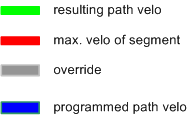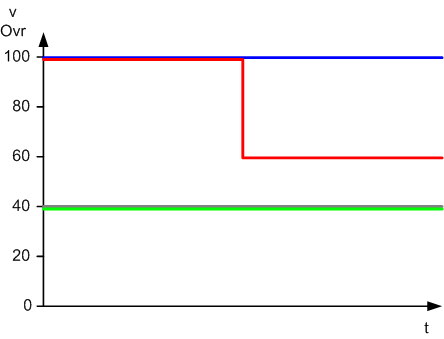Path override (interpreter override types)
The path override is a velocity override. This means that changing the override creates a new velocity, but does not affect the ramps (acceleration or jerk). The used override types only differ in terms of reference velocity.
The parameterization takes place in the interpolation channel under the group parameters.
Option 'Reduced' - based on the reduced velocity (default)
Because of the relevant dynamic parameters (braking distance, acceleration etc.) it is not possible for the programmed velocity (the blue line) be achieved in every segment. For this reason a velocity, possibly reduced, (the red line) is calculated for each geometric segment. In the standard case, the override is made with reference to this segment velocity.
The advantage of this override type is that if override values are small the machine operates with an approximately linear reduction in velocity, and this is therefore the correct setting for most applications.
v_res = v_max * Override


Option 'Original' - based on the programmed path velocity
The override value is based on the velocity programmed by the user. The maximum segment velocity only has a limiting effect.

Selection 'Reduced [0 ... >100%]' - based on internally reduced velocity with the option to specify a value greater than 100%
The override type behaves like 'Reduced'. With this override type it is possible to travel along the path more quickly than programmed in the G-Code. There is no limitation to 120%, for example. The maximum possible path velocity is limited by the maximum velocities of the axis components (G0 velocity) and their dynamics.
If limitation to a particular value, e.g. 120%, is required, this can be set in the PLC project.